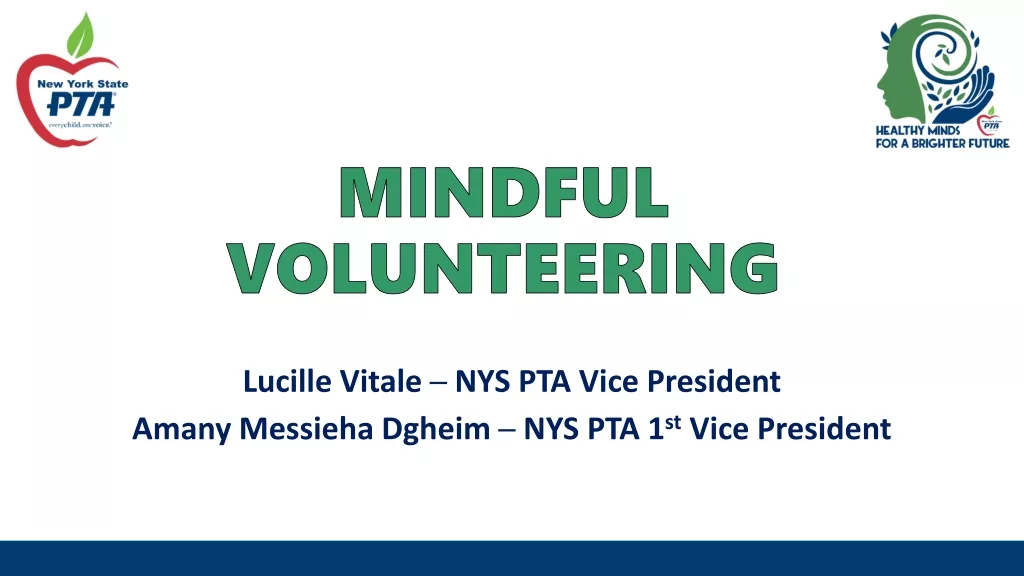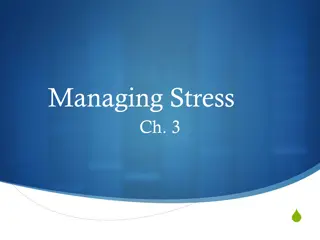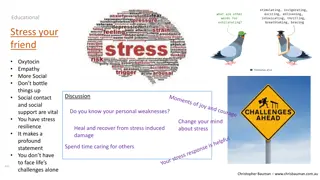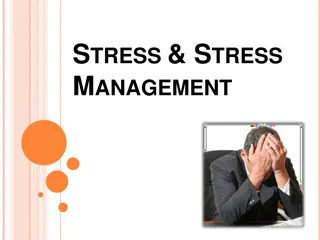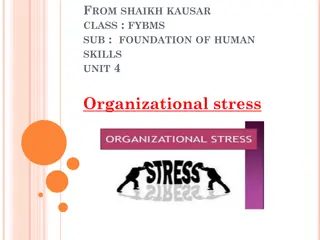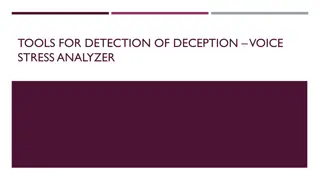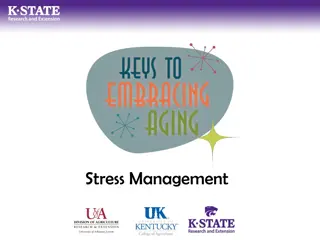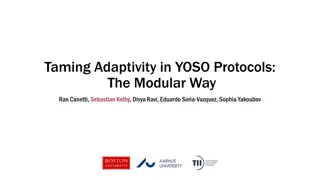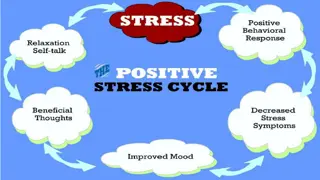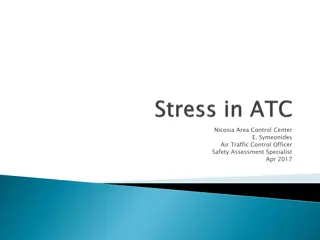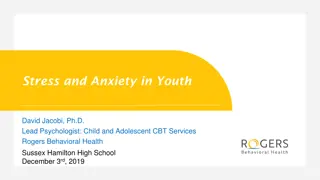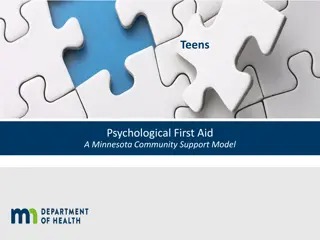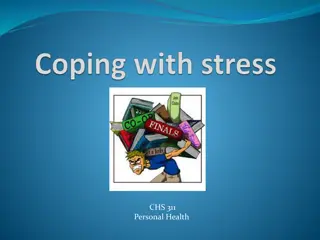Taming Stress: A Mindful Approach
Explore the dynamics of stress from a mindful perspective presented by Michele Guerra, MS, CHES. Learn strategies to tame self-defeating thinking patterns, practice reframing techniques, create affirmations, and engage in mind-taming meditations. Discover the ABCs of stress management, the power of the mind, and the impact of self-talk and perspective on resilience. Transform toxic thinking with positive habits and effective self-talk strategies.
Download Presentation

Please find below an Image/Link to download the presentation.
The content on the website is provided AS IS for your information and personal use only. It may not be sold, licensed, or shared on other websites without obtaining consent from the author.If you encounter any issues during the download, it is possible that the publisher has removed the file from their server.
You are allowed to download the files provided on this website for personal or commercial use, subject to the condition that they are used lawfully. All files are the property of their respective owners.
The content on the website is provided AS IS for your information and personal use only. It may not be sold, licensed, or shared on other websites without obtaining consent from the author.
E N D
Presentation Transcript
Stress? It depends on your point of view! Presented by Michele Guerra, MS, CHES Director, UI Wellness Center
Todays objectives Understand the role of the mind and perspective in stress Discover four ways to tame self-defeating thinking trends Practice a reframing technique Create a personal affirmation Practice a mind taming meditation
AAAbcs of stress management Avoid the stressor Adapt the stressor Accept the stressor by Building resistance or Changing your perception Tubesing & Tubesing
The power of the mind Lemon meditation
Self- talk & perspective Characteristics of Resilient People Awareness Perseverance Internal Locus of Control Thriving under pressure results, at least in part, from positive habits related to perspective, attitude and self talk. Optimism Support Sense of Humor Perspective
How do you talk to yourself? What are the recurring themes in your self talk? Is your self talk helpful or hurtful? Does your self talk increase your stress levels? Cognitive distortion Psychic tension Toxic thinking Whispers of sabotage Stinkin Thinkin
Self- talk Fact: Thoughts, emotions and behaviors all influence each other. People have a continuous stream of thoughts going through their heads Fact: People often unknowingly undermine themselves through negative, self-defeating thinking. Fact: People can learn to reframe their thinking to be more positive, realistic and helpful.
Examples I ll never be able to change I blew my whole plan (after a brief lapse) I m a total failure Why bother? I ll never ____( finish the project, get the job, raise, recognition, etc.) I m so ____ (lazy, old, stupid, etc.) I ll make a fool out of myself in front of my colleagues More?
Ways to change (tame) self-talk Thought stopping Reframing Affirmations Meditation
Reframing thoughts: A way to change your self-talk, your perspective and your stress levels Identify stressful, automatic thoughts Recognize the connections between thoughts, feelings and behaviors Identify and challenge distorted thoughts and attitudes Substitute more realistic and positive thoughts
Steps to reframing Become aware of your thoughts. Identify recurring stressful thinking trends Recognize what situations trigger these thoughts Understand your thought-emotion-behavior connections Rationally analyze the thoughts. Create more realistic, helpful thoughts. Practice and be patient.
Reframing thoughts is not the same as positive thinking
Reframing example #1 Situation: A student employee (or project team member) doesn t do what they said they would (follow through on a work task) Analysis of automatic thoughts: This is actually not true There may be some truth in parts of it I m exaggerating This has happened before what can I do to resolve this? I am putting control/ power into others hands Automatic thoughts: I m not respectable Now I have to do all this work myself I m going to get in trouble over this Now they (other student employees) are all going to do this (not follow through with their work) I m not good enough It s a plot against me! Reframed thoughts This is inconvenient, but not terrible I can figure out why this happened and how to prevent it in the future I can create solutions Resulting emotions: Unhappy Angry Overwhelmed Anxious Frustrated Disappointed Resulting emotions Empowered Annoyed Smirk
Reframing example #2 Situation: You are trying to establish a new physical activity routine. You are having difficulty finding enough time to exercise, and are not doing it. Analysis and reframing This is not true I am not lazy I actually do have a lot going on in my life this is a barrier to my being physically active I am beginning a new habit slips are normal I can look at how I spend my time I can plan ahead and problem solve my barriers Automatic thoughts I m lazy I should be able to do this I ll never do it Resulting emotions Frustrated Exhausted Resulting emotions Neutral In-control Confident Interested Visualize success Hopeful Excited Resulting actions Stay in bed Give up
Reframe these situations (Identify a negative response and how to reframe it) You made a mistake You don t understand part of the instructions or feedback you got You are planning a family reunion Your hair cut didn t turn out the way you expected You disagree with someone important You don t get a job you interview for and really wanted You leave an interview and don t feel you did very well Others?
Practice Write down a stressful automatic thought that increases stress or hinders you from attaining a goal Analyze that thought. Is it true? Realistic? Helpful? How might the thought be distorted? How has listening to, accepting this thought as truth affected your stress levels? Your overall wellness? Your work-life? Reframe the thought - create an alternative to replace the old thought with when it arises
Affirmations Affirmation (L. affirmo) - The ability to think positively about oneself, about others and the world: to feel/accept one's own worth and the worth of others; assertiveness in feeling, confirming and expressing one's values. Positive statements used to counteract negative automatic thoughts build self-esteem and self confidence reinforce and achieve one s goals Well tried and successful techniques used by astronauts, athletes and businesses and others simulate a situation and find solutions.
Creating affirmations Use I sentences Phrase affirmations in the present tense Phrase affirmations in a positive light NO: I will not procrastinate anymore YES: I set priorities and manage my time well Keep affirmations simple and direct Create affirmations that feel right to you Practice one or two affirmations at a time Repeat your affirmations often Try to believe your affirmations Include a reinforcing visualization
When & how to use affirmations Use them when reframing negative automatic thoughts Repeat them during relaxation exercises Contemplate them during meditation Write and post them where you will see them
Thought Stopping When you notice a negative automatic thought Say STOP! to yourself Or visualize a large stop sign Or use the rubber band snap Follow with a statement such as I erase that thought Immediately replace with your reframed thought or affirmation
Meditation Is a relaxed yet focused state Is NOT zoning out Helps build awareness of self defeating thoughts Helps you see things more clearly Helps you learn to tune out distractions Helps you learn to concentrate Helps you let go of things you can t control
Thank you for attending! http://www.campusrec.illinois.edu:16080/wellnesscenter Hours: M F: 8:30 am 5:00 PM For more info contact Michele Guerra 244-2205 (direct) 265-WELL (9355) mguerra@illinois.edu



